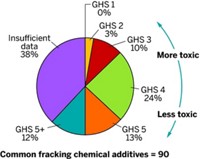Advertisement
Grab your lab coat. Let's get started
Welcome!
Welcome!
Create an account below to get 6 C&EN articles per month, receive newsletters and more - all free.
It seems this is your first time logging in online. Please enter the following information to continue.
As an ACS member you automatically get access to this site. All we need is few more details to create your reading experience.
Not you? Sign in with a different account.
Not you? Sign in with a different account.
ERROR 1
ERROR 1
ERROR 2
ERROR 2
ERROR 2
ERROR 2
ERROR 2
Password and Confirm password must match.
If you have an ACS member number, please enter it here so we can link this account to your membership. (optional)
ERROR 2
ACS values your privacy. By submitting your information, you are gaining access to C&EN and subscribing to our weekly newsletter. We use the information you provide to make your reading experience better, and we will never sell your data to third party members.
Environment
Oil Spill Leads To Fame And Fury For Makers Of Dispersant Chemicals
by Melody Voith
June 14, 2010
| A version of this story appeared in
Volume 88, Issue 24
It’s not quite the kind of attention that Nalco would have wished for. The water treatment chemicals maker has found itself tied to the disaster in the Gulf of Mexico because its products—a line of surfactants and solvent mixtures called Corexit—is the only dispersant being used by BP to break up the leaking oil.
COVER STORY
Oil Spill Leads To Fame And Fury For Makers Of Dispersant Chemicals
As of June 6, responders had deployed more than 1 million gal of Corexit in the Gulf. Approximately 303,000 gal of that amount has been injected undersea at the location of the leaking well. The Environmental Protection Agency and members of the public have expressed concerns about possible toxic effects of using such a large quantity of the chemical in the Gulf’s delicate marine ecosystem. In fact, on May 26, EPA ordered BP to reduce its use of the dispersant by 75%.
With more than 600 news stories mentioning Corexit by name, according to LexisNexis, Nalco has stayed busy issuing press releases confirming the low toxicity and safety of its product. And yet, “we’re trying to make sure we don’t get defined as a dispersant company,” Nalco spokesman Charles C. Pajor says. “Normally, we don’t even make that much of it—99% of our business has nothing to do with dispersants.”
Pajor explains that Nalco provides a range of chemicals for the oil and gas production industry, and the dispersants are a small part of the product line. Most of the firm’s business comes from selling chemicals and systems for reducing customers’ water and energy use.
Although the majority of Nalco’s employees are working on client sites, Pajor says, “we’ve got a lot of people who are dedicated to supporting the response effort to make and ship dispersants.” He adds that responsibility for the use—or misuse, if any—of Corexit belongs to BP. “In the final analysis, the decision of when, how much, and how to apply the dispersants has always been up to BP. They are the experts and the ones on the scene,” he says.
So far, the quantity of Corexit delivered to BP has brought in about $40 million to Nalco, or an additional 1% of yearly revenue, the company reports. That translates to an additional 8 cents of earnings per share for investors, according to Laurence Alexander, a chemicals analyst at Jefferies & Co.
But the reasoning behind BP’s decision to use only Corexit is unclear—EPA has approved 81 dispersants and other products for cleaning up oil spills. One place Corexit is not being applied is near the shoreline. Nalco pointed out in a June 2 statement that Corexit should be used only in open water, at least 3 miles from the coast. Such restrictions do not apply to all of the approved chemicals. For example, SC-1000, described as a surface washing agent, is designed to be used to repel oil from shore.
Kim C. Kristoff, president of Gemtek, the Phoenix-based specialty chemical firm that manufactures SC-1000, says the product is a biodegradable alkyloxypolyethoxyethanol surfactant made from corn, soy, and palm oil. Because it is non-ionic, highly water-miscible, and lipophobic, it can be used to herd oil away from coasts and marshes or toward absorbent booms. The cleaner was awarded an EPA Design for the Environment designation in 2000.
Unfortunately for Gemtek, Kristoff complains, despite making more than 100 phone calls, he has been unable to interest BP’s response team in the product, which was used in the 1989 cleanup of the Exxon Valdez spill. “Whenever they manage to stop the flow of oil into the ocean, just imagine the amount of three ships like the Valdez floating around in coastal regions,” Kristoff warns. “It will eventually come to shore. What is their plan to get rid of it?”





Join the conversation
Contact the reporter
Submit a Letter to the Editor for publication
Engage with us on Twitter